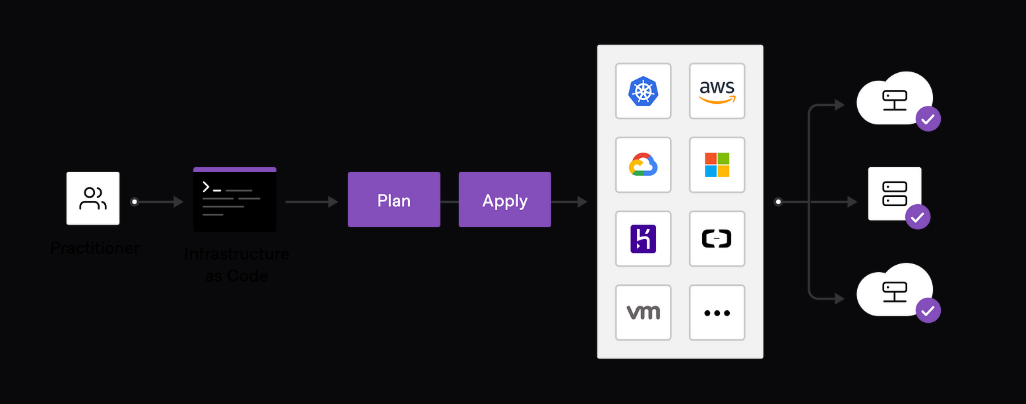Terraform Mastery Part-2
 Ayush Chaurasia
Ayush Chaurasia
1) Infrastructure Automation Tools Before Terraform: Challenges and Limitations
Chef : Chef is a configuration management tool that helped automate the setup of servers and applications configuration. While Chef was great for managing individual servers, it was more focused on configuration rather than infrastructure provisioning. It also required an agent to be installed on each server, which could become Problem for larger environments.
Puppet : Similar to Chef, Puppet was another tool focused on configuration management, helping automate the process of managing infrastructure. While it worked well for managing only for server configurations, it also struggled with scalability when dealing with dynamic cloud environments. Puppet’s language (Puppet DSL) was not as widely understood as other coding languages, which meant that teams often found it difficult to pick up and use effectively. Like Chef, it also had agents installed on each server, adding complexity.
2) What Went Wrong with Previous Technologies, and How Terraform Stands Out ?
Before Terraform came into the picture, Several tools existed before Terraform, each with its strengths, but many struggled to meet the needs of modern infrastructure management
Step-by-Step vs. Final Result:
Older Tools: You had to write step-by-step instructions to set up your infrastructure.
Terraform: You just describe what the final setup should look like, and Terraform figures out the steps to get there.
Broad Support:
Older Tools: Often required extra plugins or manual setups to support different cloud providers.
Terraform: Has built-in support for a wide range of cloud providers and services, making it easier to manage everything in one place.
Full Lifecycle Management:
Older Tools: Focused mostly on setting up and configuring servers.
Terraform: Handles the entire lifecycle of your infrastructure—from creation to updates to deletion—using code.
Remembering the State:
Older Tools: They didn't always keep track of the current state of your infrastructure, which could lead to inconsistencies.
Terraform: Keeps a detailed record of the current state, so it knows exactly what needs to be changed or added.
Terraform simplifies the whole process, keeps better track of everything, and supports a wider range of services—all while making it easier to find help and resources. Terraform modular approach also allows teams to break infrastructure into reusable components (modules). This makes it easy to scale your infrastructure while maintaining control and organization.
3) Terraform Commands
terraform help: These commands will provide you with detailed information and usage examples for each command. It's a handy way to quickly find the information you need while working with Terraform.
terraform init: Initializes a new Terraform configuration. It installs the required providers and sets up the working directory.
terraform plan: Previews the changes Terraform will make to your infrastructure, showing what will be created, modified, or destroyed.
terraform apply: Applies the changes defined in your Terraform configuration to your infrastructure (after previewing them with plan).
terraform destroy: Destroys all the resources created by Terraform. Be careful when running this, as it will remove everything.
terraform validate: Validates your Terraform configuration files, checking for syntax errors and other issues.
terraform show: Shows the current state of the infrastructure managed by Terraform, useful for inspecting the status of your resources.
4) Terraform Configuration Basics
providers: Define which cloud or service Terraform will manage resources for (e.g., AWS, Azure, Google Cloud). Providers are set up in your .tf file.
Example:
provider "aws" {
region = "us-west-2"
}
Resources: Define the actual infrastructure you want to create (e.g., EC2 instances, storage buckets).
Example:
resource "aws_instance" "example" {
ami = "ami-0c55b159cbfafe1f0"
instance_type = "t2.micro"
}
Variables: Allow you to define parameters that can be passed in, so you can reuse your configuration files for different environments or settings.
Example:
variable "instance_type" {
description = "The type of the EC2 instance"
default = "t2.micro"
}
Outputs: Used to extract values from your Terraform configuration, such as the public IP of an EC2 instance.
Example:
output "instance_ip" {
value = aws_instance.example.public_ip
}
Conclusion
In summary, Terraform has set itself apart from older tools by offering a more flexible, user-friendly way to manage infrastructure. It simplifies the process of automating and provisioning resources across multiple cloud platforms, making it a powerful choice for modern DevOps teams. If you haven’t tried Terraform yet, it’s definitely worth exploring for managing your infrastructure in a more efficient and consistent way.
Subscribe to my newsletter
Read articles from Ayush Chaurasia directly inside your inbox. Subscribe to the newsletter, and don't miss out.
Written by

Ayush Chaurasia
Ayush Chaurasia
Hey I'm Ayush. you're here to discover new insights , I'm thrilled to have you along for the journey!